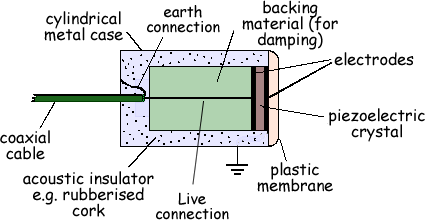    |
||||

The Piezoelectric Transducer |
||||
|
A piezoelectric transducer operates as both:
When an alternating pd is applied to the transducer, periodic changes in stress occur in the piezoelectric crystal and forced vibrations are excited which have the same frequency as the applied pd. The vibrations have maximum amplitude when this frequency is equal to one of the natural frequencies of vibration of the crystal.
The disc thickness determines its resonant frequency. Thicker the disc the lower the frequency.
The electrodes must be light and they usually consist of thin layers of silver. The one nearest the patient is connected to the earthed metal case for safety. The other is called the 'active' or 'live' electrode and is connected via a coaxial cable to a source of power (for when it is used as a transmitter) and an amplifier and cathode ray tube (for when it is used as a receiver). Clear distinct echoes are obtained using short pulses. A typical pulse time period is of the order of microseconds. It has to be this short as the transducer acts as both emitter and receiver the emitted pulse must have stopped its forced vibration of the crystal before the reflected pulse is received. Due to the small distances involved, the time of the pulse has to be very small indeed. To generate such pulses, the vibrations must be damped out as quickly as possible. This is achieved by bonding a block of damping material to the back face of the crystal. The block is made of a suitable absorbing material (e.g. araldite or other epoxy resin) which damps the disc vibrations rapidly at the end of each pulse before the next pulse is produced. This also prevents ultrasonic waves being created at the rear surface of the disc. If this was not done the ultrasonic waves from the two disc surfaces would cancel each other out.
|
||||
 |
||||

 an ultrasound generator, by applying a 'stimulating voltage' of suitable frequency, thereby causing crystal vibrations and the emission of ultrasonic waves, and
an ultrasound generator, by applying a 'stimulating voltage' of suitable frequency, thereby causing crystal vibrations and the emission of ultrasonic waves, and

